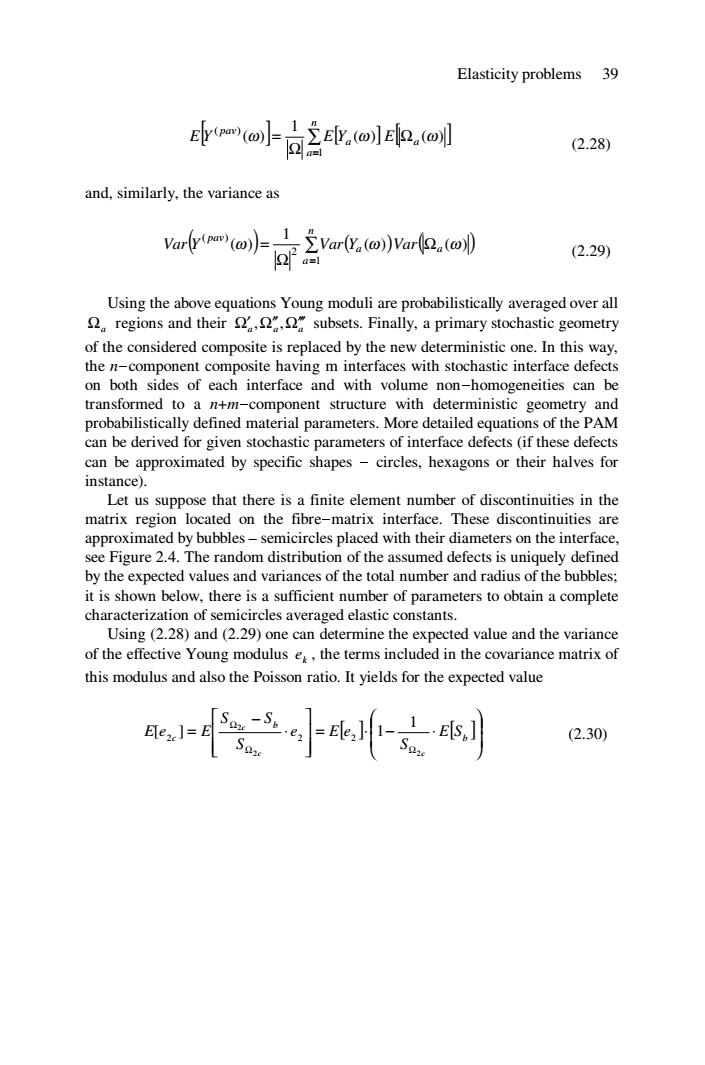正在加载图片...

Elasticity problems 39 tm@小2top.ol (2.28) and,similarly,the variance as tmo时守 var化.(o)Var(o0 (2.29) Using the above equations Young moduli are probabilistically averaged over all regions and their subsets.Finally,a primary stochastic geometry of the considered composite is replaced by the new deterministic one.In this way, the n-component composite having m interfaces with stochastic interface defects on both sides of each interface and with volume non-homogeneities can be transformed to a n+m-component structure with deterministic geometry and probabilistically defined material parameters.More detailed equations of the PAM can be derived for given stochastic parameters of interface defects (if these defects can be approximated by specific shapes -circles,hexagons or their halves for instance). Let us suppose that there is a finite element number of discontinuities in the matrix region located on the fibre-matrix interface.These discontinuities are approximated by bubbles-semicircles placed with their diameters on the interface, see Figure 2.4.The random distribution of the assumed defects is uniquely defined by the expected values and variances of the total number and radius of the bubbles; it is shown below,there is a sufficient number of parameters to obtain a complete characterization of semicircles averaged elastic constants. Using (2.28)and (2.29)one can determine the expected value and the variance of the effective Young modulus e,the terms included in the covariance matrix of this modulus and also the Poisson ratio.It yields for the expected value ase小女 (2.30)Elasticity problems 39 [ ] [ ] ( ) [ ] ( ) 1 ( ) 1 ( ) ω ω a ω n a a pav E Y E Y E Ω Ω = ∑ = (2.28) and, similarly, the variance as ( ) ( ) ( ) ( ) ( ) 1 ( ) 1 2 ( ) ω ω a ω n a a pav Var Y Var Y Var Ω Ω = ∑ = (2.29) Using the above equations Young moduli are probabilistically averaged over all Ωa regions and their a a Ωa Ω′ , subsets. Finally, a primary stochastic geometry Ω′′, ′′′ of the considered composite is replaced by the new deterministic one. In this way, the n-component composite having m interfaces with stochastic interface defects on both sides of each interface and with volume non-homogeneities can be transformed to a n+m-component structure with deterministic geometry and probabilistically defined material parameters. More detailed equations of the PAM can be derived for given stochastic parameters of interface defects (if these defects can be approximated by specific shapes - circles, hexagons or their halves for instance). Let us suppose that there is a finite element number of discontinuities in the matrix region located on the fibre-matrix interface. These discontinuities are approximated by bubbles – semicircles placed with their diameters on the interface, see Figure 2.4. The random distribution of the assumed defects is uniquely defined by the expected values and variances of the total number and radius of the bubbles; it is shown below, there is a sufficient number of parameters to obtain a complete characterization of semicircles averaged elastic constants. Using (2.28) and (2.29) one can determine the expected value and the variance of the effective Young modulus k e , the terms included in the covariance matrix of this modulus and also the Poisson ratio. It yields for the expected value [ ] [ ]⎟ ⎟ ⎠ ⎞ ⎜ ⎜ ⎝ ⎛ = ⋅ − ⋅ ⎥ ⎥ ⎦ ⎤ ⎢ ⎢ ⎣ ⎡ ⋅ − = Ω Ω Ω b b c E S S e E e S S S E e E c c c 2 2 2 1 [ ] 1 2 2 2 (2.30)